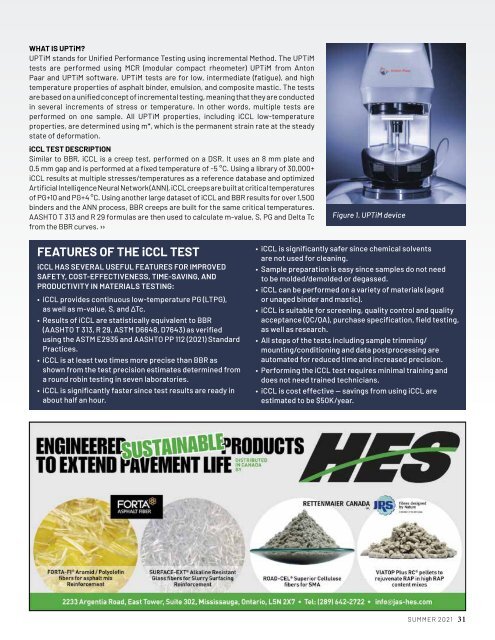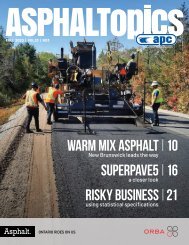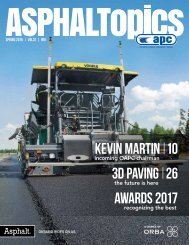ASPHALTopics | Summer 2021 | VOL 34 | NO 2
Create successful ePaper yourself
Turn your PDF publications into a flip-book with our unique Google optimized e-Paper software.
WHAT IS UPTiM?<br />
UPTiM stands for Unified Performance Testing using incremental Method. The UPTiM<br />
tests are performed using MCR (modular compact rheometer) UPTiM from Anton<br />
Paar and UPTiM software. UPTiM tests are for low, intermediate (fatigue), and high<br />
temperature properties of asphalt binder, emulsion, and composite mastic. The tests<br />
are based on a unified concept of incremental testing, meaning that they are conducted<br />
in several increments of stress or temperature. In other words, multiple tests are<br />
performed on one sample. All UPTiM properties, including iCCL low-temperature<br />
properties, are determined using m*, which is the permanent strain rate at the steady<br />
state of deformation.<br />
iCCL TEST DESCRIPTION<br />
Similar to BBR, iCCL is a creep test, performed on a DSR. It uses an 8 mm plate and<br />
0.5 mm gap and is performed at a fixed temperature of -5 °C. Using a library of 30,000+<br />
iCCL results at multiple stresses/temperatures as a reference database and optimized<br />
Artificial Intelligence Neural Network (ANN), iCCL creeps are built at critical temperatures<br />
of PG+10 and PG+4 °C. Using another large dataset of iCCL and BBR results for over 1,500<br />
binders and the ANN process, BBR creeps are built for the same critical temperatures.<br />
AASHTO T 313 and R 29 formulas are then used to calculate m-value, S, PG and Delta Tc<br />
from the BBR curves. ››<br />
Figure 1. UPTiM device<br />
FEATURES OF THE iCCL TEST<br />
iCCL HAS SEVERAL USEFUL FEATURES FOR IMPROVED<br />
SAFETY, COST-EFFECTIVENESS, TIME-SAVING, AND<br />
PRODUCTIVITY IN MATERIALS TESTING:<br />
• iCCL provides continuous low-temperature PG (LTPG),<br />
as well as m-value, S, and ΔTc.<br />
• Results of iCCL are statistically equivalent to BBR<br />
(AASHTO T 313, R 29, ASTM D6648, D7643) as verified<br />
using the ASTM E2935 and AASHTO PP 112 (<strong>2021</strong>) Standard<br />
Practices.<br />
• iCCL is at least two times more precise than BBR as<br />
shown from the test precision estimates determined from<br />
a round robin testing in seven laboratories.<br />
• iCCL is significantly faster since test results are ready in<br />
about half an hour.<br />
• iCCL is significantly safer since chemical solvents<br />
are not used for cleaning.<br />
• Sample preparation is easy since samples do not need<br />
to be molded/demolded or degassed.<br />
• iCCL can be performed on a variety of materials (aged<br />
or unaged binder and mastic).<br />
• iCCL is suitable for screening, quality control and quality<br />
acceptance (QC/QA), purchase specification, field testing,<br />
as well as research.<br />
• All steps of the tests including sample trimming/<br />
mounting/conditioning and data postprocessing are<br />
automated for reduced time and increased precision.<br />
• Performing the iCCL test requires minimal training and<br />
does not need trained technicians.<br />
• iCCL is cost effective — savings from using iCCL are<br />
estimated to be $50K/year.<br />
SUMMER <strong>2021</strong> 31

















